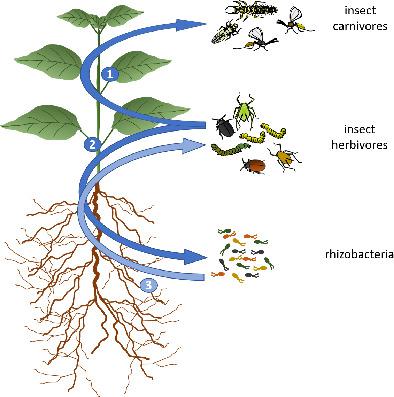当前位置:
X-MOL 学术
›
Ecol. Entomol.
›
论文详情
Our official English website, www.x-mol.net, welcomes your
feedback! (Note: you will need to create a separate account there.)
Bidirectional plant‐mediated interactions between rhizobacteria and shoot‐feeding herbivorous insects: a community ecology perspective
Ecological Entomology ( IF 2.0 ) Pub Date : 2020-10-23 , DOI: 10.1111/een.12966 Julia Friman 1 , Ana Pineda 2 , Joop J.A. Loon 1 , Marcel Dicke 1, 3
Ecological Entomology ( IF 2.0 ) Pub Date : 2020-10-23 , DOI: 10.1111/een.12966 Julia Friman 1 , Ana Pineda 2 , Joop J.A. Loon 1 , Marcel Dicke 1, 3
Affiliation

|
Plants interact with various organisms, aboveground as well as belowground. Such interactions result in changes in plant traits with consequences for members of the plant‐associated community at different trophic levels. Research thus far focussed on interactions of plants with individual species. However, studying such interactions in a community context is needed to gain a better understanding. Members of the aboveground insect community induce defences that systemically influence plant interactions with herbivorous as well as carnivorous insects. Plant roots are associated with a community of plant‐growth promoting rhizobacteria (PGPR). This PGPR community modulates insect‐induced defences of plants. Thus, PGPR and insects interact indirectly via plant‐mediated interactions. Such plant‐mediated interactions between belowground PGPR and aboveground insects have usually been addressed unidirectionally from belowground to aboveground. Here, we take a bidirectional approach to these cross‐compartment plant‐mediated interactions. Recent studies show that upon aboveground attack by insect herbivores, plants may recruit rhizobacteria that enhance plant defence against the attackers. This rearranging of the PGPR community in the rhizosphere has consequences for members of the aboveground insect community. This review focusses on the bidirectional nature of plant‐mediated interactions between the PGPR and insect communities associated with plants, including (a) effects of beneficial rhizobacteria via modification of plant defence traits on insects and (b) effects of plant defence against insects on the PGPR community in the rhizosphere. We discuss how such knowledge can be used in the development of sustainable crop‐protection strategies.
中文翻译:

根际细菌与以枝条为食的食草昆虫之间的双向植物介导相互作用:群落生态学视角
植物与地上和地下的各种生物相互作用。这种相互作用导致植物性状的变化,对不同营养水平的植物相关群落成员产生影响。迄今为止的研究主要集中在植物与单个物种的相互作用上。然而,需要在社区环境中研究这种相互作用才能更好地理解。地上昆虫群落的成员诱导防御系统地影响植物与食草和食肉昆虫的相互作用。植物根系与促进植物生长的根际细菌 (PGPR) 群落有关。该 PGPR 群落调节昆虫诱导的植物防御。因此,PGPR 和昆虫通过植物介导的相互作用间接相互作用。地下 PGPR 和地上昆虫之间的这种植物介导的相互作用通常是从地下到地上单向解决的。在这里,我们对这些跨室植物介导的相互作用采用双向方法。最近的研究表明,在昆虫食草动物的地上攻击时,植物可能会招募根际细菌,增强植物对攻击者的防御。根际 PGPR 群落的这种重新排列对地上昆虫群落的成员产生了影响。本综述侧重于植物介导的 PGPR 与与植物相关的昆虫群落之间相互作用的双向性质,包括(a)有益根际细菌通过改变植物防御性状对昆虫的影响和(b)植物防御昆虫对根际 PGPR 群落的影响。我们讨论如何将这些知识用于制定可持续的作物保护战略。
更新日期:2020-10-23
中文翻译:

根际细菌与以枝条为食的食草昆虫之间的双向植物介导相互作用:群落生态学视角
植物与地上和地下的各种生物相互作用。这种相互作用导致植物性状的变化,对不同营养水平的植物相关群落成员产生影响。迄今为止的研究主要集中在植物与单个物种的相互作用上。然而,需要在社区环境中研究这种相互作用才能更好地理解。地上昆虫群落的成员诱导防御系统地影响植物与食草和食肉昆虫的相互作用。植物根系与促进植物生长的根际细菌 (PGPR) 群落有关。该 PGPR 群落调节昆虫诱导的植物防御。因此,PGPR 和昆虫通过植物介导的相互作用间接相互作用。地下 PGPR 和地上昆虫之间的这种植物介导的相互作用通常是从地下到地上单向解决的。在这里,我们对这些跨室植物介导的相互作用采用双向方法。最近的研究表明,在昆虫食草动物的地上攻击时,植物可能会招募根际细菌,增强植物对攻击者的防御。根际 PGPR 群落的这种重新排列对地上昆虫群落的成员产生了影响。本综述侧重于植物介导的 PGPR 与与植物相关的昆虫群落之间相互作用的双向性质,包括(a)有益根际细菌通过改变植物防御性状对昆虫的影响和(b)植物防御昆虫对根际 PGPR 群落的影响。我们讨论如何将这些知识用于制定可持续的作物保护战略。











































 京公网安备 11010802027423号
京公网安备 11010802027423号